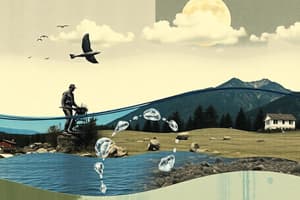Podcast
Questions and Answers
What is the Hydrologic Cycle?
What is the Hydrologic Cycle?
- The process of water evaporating from plants
- Natural circulation of raw water on or above the Earth's surface (correct)
- The conversion of water into ice
- Water flowing through rivers and streams
What is evaporation?
What is evaporation?
Water is placed in the air by evaporation from bodies of water.
What is transpiration?
What is transpiration?
Moisture placed in the air by the plants as they sweat.
What is precipitation?
What is precipitation?
What is infiltration?
What is infiltration?
What is runoff?
What is runoff?
What are the classifications of water sources?
What are the classifications of water sources?
What is Contact Time (CT)?
What is Contact Time (CT)?
Turbidity refers to ______.
Turbidity refers to ______.
What are dissolved solids?
What are dissolved solids?
What does TDS stand for?
What does TDS stand for?
Which of the following are characteristics of water?
Which of the following are characteristics of water?
What is the effect of temperature on water taste?
What is the effect of temperature on water taste?
What are chemical properties of water?
What are chemical properties of water?
What is acidity/alkalinity measured by?
What is acidity/alkalinity measured by?
What causes hardness in water?
What causes hardness in water?
What does corrosiveness in water refer to?
What does corrosiveness in water refer to?
What are the types of contamination of water?
What are the types of contamination of water?
What is the primary purpose of field water purification?
What is the primary purpose of field water purification?
What is the function of multimedia/ultra/micro filters?
What is the function of multimedia/ultra/micro filters?
What does a cartridge filter do?
What does a cartridge filter do?
What is reverse osmosis?
What is reverse osmosis?
What is disinfection in water treatment?
What is disinfection in water treatment?
What are basic components in field water purification?
What are basic components in field water purification?
What does TB MED 577 refer to?
What does TB MED 577 refer to?
What does 68S relate to?
What does 68S relate to?
What are the types of water?
What are the types of water?
What does PPM stand for?
What does PPM stand for?
What does contaminated water mean?
What does contaminated water mean?
What does polluted water contain?
What does polluted water contain?
What defines palatable water?
What defines palatable water?
What defines potable water?
What defines potable water?
What are the categories of water sources?
What are the categories of water sources?
What defines fresh water?
What defines fresh water?
What is brackish water?
What is brackish water?
What defines saline water?
What defines saline water?
What does OE stand for?
What does OE stand for?
What are variables in the OE?
What are variables in the OE?
What does JIIM stand for?
What does JIIM stand for?
What is environmental stewardship?
What is environmental stewardship?
What are the types of water sources?
What are the types of water sources?
What does ISAP stand for?
What does ISAP stand for?
What does PMCS stand for?
What does PMCS stand for?
What is a warning in maintenance?
What is a warning in maintenance?
What does caution refer to in maintenance?
What does caution refer to in maintenance?
What is water reconnaissance?
What is water reconnaissance?
What are the phases of planning?
What are the phases of planning?
What does surface water include?
What does surface water include?
What does groundwater refer to?
What does groundwater refer to?
Who are the personnel involved in water treatment?
Who are the personnel involved in water treatment?
What does pH stand for?
What does pH stand for?
What does TAMMS stand for?
What does TAMMS stand for?
What is field level maintenance?
What is field level maintenance?
What does sustainment level maintenance focus on?
What does sustainment level maintenance focus on?
A fault is a ______ in a piece of equipment that doesn't prevent operation.
A fault is a ______ in a piece of equipment that doesn't prevent operation.
What are the phases of planning?
What are the phases of planning?
Flashcards
Hydrologic Cycle
Hydrologic Cycle
The natural movement of water on, in, and above the Earth's surface.
Evaporation
Evaporation
Water turning into vapor and rising into the atmosphere.
Transpiration
Transpiration
Water released into the air by plants.
Precipitation
Precipitation
Signup and view all the flashcards
Infiltration
Infiltration
Signup and view all the flashcards
Runoff
Runoff
Signup and view all the flashcards
Surface Water
Surface Water
Signup and view all the flashcards
Groundwater
Groundwater
Signup and view all the flashcards
Contact Time (CT)
Contact Time (CT)
Signup and view all the flashcards
Turbidity
Turbidity
Signup and view all the flashcards
Dissolved Solids
Dissolved Solids
Signup and view all the flashcards
Total Dissolved Solids (TDS)
Total Dissolved Solids (TDS)
Signup and view all the flashcards
Water Characteristics
Water Characteristics
Signup and view all the flashcards
Color (Water)
Color (Water)
Signup and view all the flashcards
Odor/Taste (Water)
Odor/Taste (Water)
Signup and view all the flashcards
Water Temperature
Water Temperature
Signup and view all the flashcards
Acidity/Alkalinity (Water)
Acidity/Alkalinity (Water)
Signup and view all the flashcards
Water Hardness
Water Hardness
Signup and view all the flashcards
Water Corrosiveness
Water Corrosiveness
Signup and view all the flashcards
Contamination
Contamination
Signup and view all the flashcards
PPM
PPM
Signup and view all the flashcards
Potable Water
Potable Water
Signup and view all the flashcards
Study Notes
Hydrologic Cycle
- Represents the natural circulation of water in various forms on, in, or above the Earth's surface.
Evaporation
- Process where water vapor enters the atmosphere from surface bodies of water.
Transpiration
- Release of moisture into the air by plants through their leaves, similar to sweating.
Precipitation
- Water returns to the Earth in forms such as rain, snow, sleet, or hail.
Infiltration
- Process whereby water penetrates the soil and ground layers.
Runoff
- Water from precipitation that moves over the land and replenishes lakes, rivers, and streams.
Classifications of Water Sources
- Surface Water: Includes rivers, streams, and lakes.
- Ground Water: Found in wells and springs.
- Sea Water: Includes the saline bodies of water.
- Precipitation: Encompasses rain, snow, and ice.
Contact Time (CT)
- Refers to the duration chlorine is in contact with water for effective disinfection.
Turbidity
- Indicates water clarity, where higher turbidity reflects muddy or unclear conditions.
Dissolved Solids
- Refers to invisible gases and other substances dissolved in water, essential for water quality assessment.
Total Dissolved Solids (TDS)
- Represents the total amount of dissolved solids in water, quantified in parts per million (ppm).
Characteristics of Water
- Key indicators include turbidity, color, odor/taste, and temperature.
Color
- The color of water is attributed to various colored substances present in it.
Odor/Taste
- There is no established standard for odor and taste in water quality.
Temperature
- Water temperature affects perception; warm water can taste flat, while cooler water is often more palatable.
Chemical Properties
- Key chemical properties include acidity/alkalinity, hardness, corrosiveness, and TDS.
Acidity/Alkalinity
- Measured by pH levels; indicates the balance of acids and bases in water.
Hardness
- Caused by the presence of salts such as calcium, magnesium, iron, manganese, and various anions.
Corrosiveness
- Refers to water's tendency to dissolve metals and other substances due to dissolved gases.
Contamination of Water
- Can arise from organic/microbial sources, industrial waste, or chemical, biological, radiological, and nuclear (CBRN) contamination.
Field Water Purification
- Aims to ensure water is safe for human consumption through several purification processes.
Multimedia/Ultra/Micro Filters
- Filters designed to remove large and small solids using polymer chemicals.
Cartridge Filter
- Utilizes a filtration system to eliminate suspended solids after multimedia filtration.
Reverse Osmosis
- Separation technique that effectively removes dissolved and suspended solids from water.
Disinfection
- Involves adding chlorine to destroy harmful bacteria remaining in water.
Basic Components in Field Water Purification
- Consists of strainer, filter elements, reverse osmosis components, and disinfection methods.
TB MED 577
- Represents a critical reference for water purity standards and guidelines.
68S
- Focuses on Preventive Medicine while conducting health inspections to approve water sources.
Types of Water
- Classified into contaminated, polluted, palatable, and potable categories.
PPM
- An abbreviation for Parts Per Million, a common measurement in water quality analysis.
Contaminated Water
- Water that contains harmful organisms or substances that pose health risks.
Polluted Water
- Water laden with hazardous substances such as waste or industrial pollutants.
Palatable Water
- Clean in appearance but may not be safe for consumption; lacks undesirable elements like color, turbidity, and odor.
Potable Water
- Safe for human consumption; devoid of harmful microorganisms, chemicals, and toxins.
Categories of Water Sources
- Differentiated into fresh water, brackish water, and saline water based on salinity levels.
Fresh Water
- Contains less than 1500 ppm of Total Dissolved Solids.
Brackish Water
- Salinity ranges from 1500 ppm to 15000 ppm TDS.
Saline Water
- Exceeds 15000 ppm of TDS, commonly found in oceans and seas.
Operational Environment (OE)
- Encompasses factors affecting operations such as political, military, economic, social, information, infrastructure, physical environment, and time.
JIIM
- Stands for Joint/Joint Task Force, Interagency, Intergovernmental, Multinational collaboration.
Environmental Stewardship
- Focuses on compliance, restoration, prevention, and conservation initiatives.
Types of Water Sources
- Divided into flowing sources like rivers and streams, and impounded sources like lakes and ponds.
Individual Student Assessment Plan (ISAP)
- Tailored assessment strategy for individual student learning needs.
Preventive Maintenance Checks and Services (PMCS)
- Regular maintenance checks to ensure equipment functions effectively.
Warning
- Alerts users about hazardous situations that may lead to severe injury or death.
Caution
- Alerts users to potential equipment damage or mission compromise due to non-compliance.
Water Reconnaissance
- A specialized survey to collect data on water sources and storage/distribution options.
Phase Planning
- Involves preliminary planning, reconnaissance, and reporting phases to streamline operations.
Surface Water
- Comprises bodies of water such as rivers, lakes, streams, and oceans.
Ground Water
- Refers to water sourced from wells and natural springs.
Personnel and Equipment
- Essential support roles include water treatment specialists and medical evaluations.
pH
- Represents the potential hydrogen concentration, indicating the acidity or alkalinity of water.
The Army Maintenance Management System (TAMMS)
- A comprehensive approach for managing army maintenance activities.
Field Level Maintenance
- Basic operator or crew-level maintenance focused on immediate equipment upkeep.
Sustainment Level Maintenance
- Involves repairing components and systems at a more extensive repair level.
Fault
- Describes defects in equipment that do not entirely hinder operation.
Phases
- Encompasses preliminary, report, and reconnaissance stages of planning and assessment.
Studying That Suits You
Use AI to generate personalized quizzes and flashcards to suit your learning preferences.




